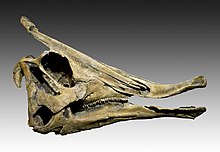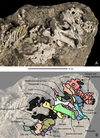Saurolophus
| Saurolophus | |
|---|---|

| |
| Mounted S. angustirostris skeleton at Nagoya City Science Museum | |
| Scientific classification | |
| Domain: | Eukaryota |
| Kingdom: | Animalia |
| Phylum: | Chordata |
| Clade: | Dinosauria |
| Clade: | †Ornithischia |
| Clade: | †Ornithopoda |
| Family: | †Hadrosauridae |
| Subfamily: | †Saurolophinae |
| Tribe: | †Saurolophini |
| Genus: | †Saurolophus Brown, 1912 |
| Type species | |
| †Saurolophus osborni Brown, 1912
| |
| Other species | |
| |
Saurolophus (
Saurolophus is distinguished by a spike-like crest which projects up and back from the skull. It was a
Discovery and history

Barnum Brown recovered the first described remains of Saurolophus in 1911, including a nearly complete skeleton (
Instead, more abundant remains from Asia have provided more data. Initial remains were not promising; a partial fragmentary
Species

Two species are regarded as valid today: the type species S. osborni, and S. angustirostris. S. osborni (Brown, 1912) is known from a skull and skeleton, two other complete skulls, and skull fragments. S. angustirostris (Rozhdestvensky, 1952) is known from at least 15 specimens.[7] It differs from S. osborni by some details of the skull, as well as in the pattern of scales found in skin impressions. The Mongolian species had a longer skull (by 20%) and the front of the snout (the premaxillary bones) were more upwardly directed.[8] S. angustirostris also had a distinctive row of rectangular scales along the midline of the back and tail, known as 'midline feature-scales'; these are not currently preserved in S. osborni. In S. angustirostris, the scales on the tail flank were arranged in vertical patterns, which may have corresponded to striped coloration in life. This area was covered in radial scale patterns in S. osborni, possibly indicating a more mottled or spotted coloration.[9]

S. kryschtofovici (Riabinin, 1930) is not considered valid; either it is regarded as a dubious name,[10][7] or as a synonym of S. angustirostris[6] (although the name antedates S. angustirostris).[11]
Until a 2011 reevaluation of the species by
In 1939–40, two partial skeletons were found in the late Maastrichtian age Moreno Formation of California. These specimens were referred to cf. Saurolophus sp. In 2010, one of the skulls was instead assigned to Edmontosaurus.[12] A 2013 study placed the two specimens in a new species, S. morrisi.[11] In 2014, the species was reassigned to a new genus, Augustynolophus.[13]
Description

Saurolophus is known from material including nearly complete skeletons, giving researchers a clear picture of its bony anatomy. S. osborni, the rarer Albertan species, was around 8.2–8.5 m (27–28 ft) long, with its skull 1.0 m (3.3 ft) long.[14][15] It has been estimated to have weighed around 3 tonnes (3.0 long tons; 3.3 short tons).[15] S. angustirostris, the Mongolian species, was larger; it got as large as 13 m (43 ft) in length, and larger remains are reported. It has been estimated to have potentially weighed up to 11 tonnes (11 long tons; 12 short tons).[15] The largest known skull of S.angustirostris measures 1.22 m (4.0 ft) in length.[8] Aside from size, the two species are virtually identical, with differentiation hindered by lack of study.[10]
Skull

The most distinctive feature of Saurolophus is its cranial crest, which is present in young individuals, but is smaller. It is long and spike-like and projects upward and backward at about a 45° angle, starting from over the eyes. This crest is often described as solid, but appears to be solid only at the point, with internal chambers that may have had a respiratory and/or heat-regulation function.[16] The unique crest of Saurolophus is made up almost completely by the nasal bones, and in S. angustirostris it is solid.[clarification needed] In adult specimens the crests are a rounded triangular shape in cross section. The crest protrudes past the edge of the skull backwards. Thin processes from the frontals and prefrontals extend along the underside of the crest, probably to strengthen it. At the end of the crest is a swelling of the nasal, which is often termed differently.[8]
The holotype of S. angustirostris is a skull and postcrania, so the cranium of the species is well-described. Bell et al. re-evaluated the entire species in a 2011 publication with
Classification

Barnum Brown, who described the first specimens, put it in its own subfamily in "Trachodontidae" (=Hadrosauridae), the Saurolophinae. At the time, this also included Corythosaurus and Hypacrosaurus, the only well-known examples of what would become the Lambeosaurinae.[3] Brown thought that Saurolophus had an expanded tip to the ischium bone in the hip, as dinosaurs now recognized as lambeosaurines had, but this appears to have been based on a mistakenly associated lambeosaurine ischium. Additionally, he misinterpreted the crests of Saurolophus and lambeosaurines as being made of the same bones.[17]
Most publications before 2010 classified Saurolophus as a member of Hadrosaurinae, often known colloquially as the "flat-headed hadrosaurs". In 2010, the subfamily Saurolophinae was brought back into use because Hadrosaurus appears to have branched off prior to the "hadrosaurine"–lambeosaurine split. As a result, Hadrosaurinae by definition cannot include the traditional "hadrosaurines". Saurolophinae is the oldest available name for the former "hadrosaurine" clade. Saurolophus, as the name suggests, is a saurolophine, as it has a saurolophine pelvis and a (largely) solid crest.[18]
The following cladogram of hadrosaurid relationships was published in 2013 by Alberto Prieto-Márquez et al. in Acta Palaeontologica Polonica:[19]
| Saurolophinae |
| ||||||||||||||||||||||||||||||||||||||||||||||||||||||||||||||||||||||||||||||||||||||||||||||||||||||||||||
Paleobiology
Feeding
As a
Crest function

The distinctive spike-like crest of Saurolophus has been interpreted in multiple ways, and could have had multiple functions. Brown compared it to the crest of a
Ontogeny

In 2015 Leonard Dewaele and colleagues described a small and partial nest containing several juveniles of S. angustirostris. The specimen (MPC-D 100/764) was recovered from the notorious Dragon's Tomb assambleage of the Nemegt Formation. The team noted that among remains, three or even four juveniles can be recognized, and two fragmentary eggshells were found in association. Juveniles within this block were identified as perinates, as they had skull lengths less than five percent of the length of the skulls of the adults, indicating they were in the earliest developmental stage at the time of their deaths. Based on these juveniles, Dewaele and team indicated that during the ontogeny of S. angustirostris the distinct crest found in adults was poorly developed in infancy, the snout grew proportionally longer, the orbit became more oval-shaped, the doming of the frontal became less prominent, and the coronoid process became higher.[23]
Social behavior
Bell and team in 2018 described the famous Dragon's Tomb assambleage of the Altan Uul II locality, Nemegt Formation, which contains a large-sized
Paleopathology

David W.E. Hone and Mahito Watabe in 2011 reported the left humerus of a nearly complete S. angustirostris skeleton (MPC-D 100/764) from the Bügiin Tsav locality of the Nemegt Formation, which was
Daily activity
Comparisons between the
Paleoenvironment
Horseshoe Canyon Formation
S. osborni is known only from the upper part (unit 4) of the
Nemegt Formation

S. angustirostris was one of the largest herbivores of the
S. angustirostris was common, and would have been an important large herbivore in the Nemegt Formation. By comparison, S. osborni was rare in the Horseshoe Canyon Formation, and faced competition from other duckbills (genus Hypacrosaurus).[citation needed]
See also
References
- hdl:2246/1401.
- hdl:2246/1415.
- ^ hdl:2246/1734.
- ^ Riabinin, Anatoly Nikolaenvich, N. (1930). "On the age and fauna of the dinosaur beds on the Amur River". Mémoir, Société Mineral Russia (in Russian). 59: 41–51.
{{cite journal}}: CS1 maint: multiple names: authors list (link) - Doklady Akademii Nauk SSSR(in Russian). 86 (2): 405–408.
- ^ ISBN 0-89950-917-7.
- ^ ISBN 0-520-24209-2.
- ^ .
- PMID 22319623.
- ^ ISBN 0-521-55476-4.
- ^ .
- doi:10.1139/E10-062.
- S2CID 131049979.
- ^ Lull, Richard Swann; Wright, Nelda E. (1942). Hadrosaurian Dinosaurs of North America. Geological Society of America Special Paper 40. Geological Society of America. p. 226.
- ^ a b c Paul, Greg (2010). The Princeton Field Guide to Dinosaurs. New Jersey: Princeton University Press. p. 335.
- ^ a b Maryańska, Teresa; Osmólska, Halszka (1981). "Cranial anatomy of Saurolophus angustirostris with comments on the Asian Hadrosauridae (Dinosauria)" (PDF). Palaeontologia Polonica. 42: 5–24.
- ^ Sternberg, Charles M. (1954). "Classification of American duckbilled dinosaurs". Journal of Paleontology. 28 (3): 382–383.
- .
- .
- JSTOR 2412696.
- S2CID 88689241.
- ISBN 0-517-46890-5.
- PMID 26466354.
- .
- .
- S2CID 33253407.
- ^ ISBN 0-691-05900-4.
- ^ ISBN 0-520-24209-2.
- ^ Lehman, T. M., 2001, Late Cretaceous dinosaur provinciality: In: Mesozoic Vertebrate Life, edited by Tanke, D. H., and Carpenter, K., Indiana University Press, pp. 310-328.
- ^ Sullivan, R.M. and Lucas, S. G. (2006). "The Kirtlandian land-vertebrate "age"–faunal composition, temporal position and biostratigraphic correlation in the nonmarine Upper Cretaceous of western North America." Pp. 7-29 in Lucas, S. G. and Sullivan, R.M. (eds.), Late Cretaceous vertebrates from the Western Interior. New Mexico Museum of Natural History and Science Bulletin 35.
- ISBN 978-0-385-47775-8
External links
![]() Data related to Saurolophus at Wikispecies
Data related to Saurolophus at Wikispecies






